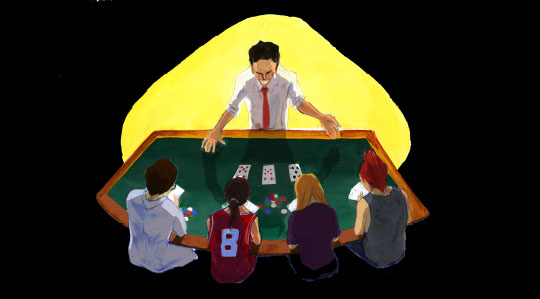The ability to problem-solve effectively is very important to Austin* ’16, which is why he discussed current events every week with the Society of Global Affairs and did Ethics Bowl last year.
“I like to think that everything I do is related to problem solving because I think that’s what you do in a career,” Austin said.
During the summer, Austin spent a week at Cal Poly, San Luis Obispo, learning about possible majors and career options in engineering. He also did a two-week program at UCLA, where students find connections between visual arts and the sciences. Austin found the program at UCLA particularly relevant because he is interested in doing both fine arts and engineering in college.
In addition to taking AP Biology, AP Physics C: Mechanics and AP Studio Art, Austin will be in four other AP classes.
Austin would like to do the Brown-RISD Dual Degree Program, so he plans to apply early to Brown University and later to the Rhode Island School of Design if he is admitted.
Most days, Homer* ’16 walks home from school on Ventura or Moorpark. It gives him 45 minutes to think or listen to his favorite kinds of music: classic rock, film scores and Broadway show tunes. When he gets home, he does his work in silence because that’s the way he always has, he said.
Homer loves theater, film and music, maybe because his father works in the entertainment industry, he said. Recently, the auditions for West Side Story have been on his mind.
During the summer, Homer did a two-week choir program at Idyllwild Arts, worked as a host at California Pizza Kitchen, wrote the first draft of his college essay and filled out half of the Common App.
Homer would like to go to a small to medium size liberal arts school with a good arts and history program because he is interested in historical fiction work.
“I’ve always been a huge fan, and this is where actually the arts could help, of writers like Dan Brown and Michael Craig who have been able to blend history and science into thriller novels,” Homer said.
For now, his top choices are Northwestern University, Kenyon College and Wesleyan University, three schools that meet his requirements.
When her summer break had just begun, Virginia* ’16 found it hard to relax.
“If I just sat still and watched a couple hours of TV, I’d get so anxious that I’d have to get up and go take a walk just because I could not stand being unproductive,” Virginia said.
Although it got easier for her to unwind later that summer, Virginia still kept herself busy with a number of activities. She was a counselor at a program for minority children, she volunteered at a hospital, finished up old paintings and did cross country training.
Virginia also did some work on her college essay and list of extracurricular activities and has launched her art supplement page online.
Most of the schools she has been looking at are liberal arts colleges and Ivy League schools, though she also likes Johns Hopkins University and Duke University, schools she saw during the school organized college tour trip last year.
“I think I still have a lot of work to do in terms of figuring out what school I would see myself at,” Virginia said.
When eighth period ends on a typical school day, Willa* ’16 quickly goes to the locker room, changes, puts on her shoes and mentally prepares herself for two hours or more of lifting, conditioning on the track or basketball practice in the gym.
Willa has come a long way since she first started to shoot hoops in kindergarten, playing at travel tournaments in front of college recruiters in July. She talked a little with Division II and III coaches after her games, but she had most of her conversations with recruiters through e-mails, calls and texts in August.
To keep in shape during the summer, Willa trained with coaches once or twice a week and did sprints around her neighborhood.
Willa wants to go to a liberal arts college because she wants to keep her options open for the future. She is curious about human anatomy, but she is not yet sure what she would like to major in.
“Coming from the athletic world, I’m interested in what happens to our bodies when they break down or when they’re sore,” Willa said.





























